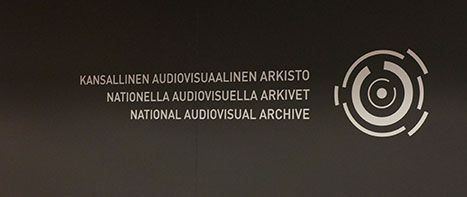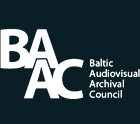BAAC annual conference 2012 report

2012 October, Helsinki
For the BAAC board, the conference started already the evening before the actual conference, with a meeting on premises of the Finnish Jazz & Pop Archive. As always, a last check of every little detail that already and reassuringly had been thought of by the local hosts the Finnish National Audiovisual Archive (KAVA), the Finnish Broadcasting Company (YLE), the Finnish Jazz and Pop Archive (JAPA) and the Finnish Institute of Recorded Sound.
One of the most important items on the agenda was the venue and dates for next year´s BAAC conference. It was decided that the conference should be held in Vilnius, Lithuania in the autumn of 2013.
Next morning, BAAC president Zane Grosa opened the conference in the KAVA cinema hall by welcoming everyone, and emphasized that it is the first time BAAC holds a conference outside the Baltic States. She also expressed a hope that this conference will create closer ties with the Scandinavian colleagues, and invited everyone to become active in the work of BAAC. The keynote speaker this morning was Kai Ekholm, director of the National Library ofFinland. He especially dwelt on the present difficult budgetary situation of many memory institutions, and what can be achieved in spite of this situation. His advice was to form cooperative alliances between institutions, organizations and the corporate world.
After nine years of existence, it should be noted that the BAAC and the conference were originally founded to create an opportunity for exchange of information and professional experience for the Baltic States of Estonia, Latvia and Lithuania. The BAAC founders were representatives of the Baltic States, Norway, Sweden and Canada. Since then, the organization has attracted interest and membership from countries outside this sphere.
The first session opened with a presentationby Sanna Marttila (Aalto University, School of Art, Design and Architecture, Finland) on "Creating meaningful access - lessons from Euscreen".
It was followed by another presentation on the access theme by Jolė Stimbirytė (Lithuanian Central State Archive, Lithuania), "Lithuanian documentaries on the Internet", which informed about making important material easily available for both the general public and academic research. This is a process that is going on in several countries in Europe these days.
Copyright is another aspect of access that is always present. Eevi Kärdla (Tartu City Museum, Estonia) discussed this under the heading "Copyright law and data protection: on the example of the photographic collection of the Tartu City Museum".Of course, the copyright problems are always present in the former Soviet occupied countries - a regime, that didn't recognize international copyright conventions.
Access can be also a technical question. Hiroko Ito (JVC Advanced Media) in her presentation "Archiving and Migration Solutions for Optical Disc" presented an alternative of long term storage and access for audiovisual content that is a part of a smaller collection.
The first post-lunch session on the first day contained an inspiring overview by Katri Vänttinen (YLE, Finland) on the subject of "Metadata - key to the archives". The core of YLE´s work in this area is the company's archival policy and a strict control of the metadata flow. After this presentation none could leave this conference without the conviction that content still is the king, but also that metadata definitely is the queen.
"Small is beautiful" - often! Tommy Sjöberg (Folkmusikens hus, Sweden) gave an inspiring picture of the opportunities of a smaller, active, regional non-governmental organization's audiovisual archive.
The second session in the afternoon started with Agata Ners (National Audiovisual Institute, Poland), giving an overview on the Polish audiovisual archiving situation and, especially, projects directed towards young people. The presentation included very interesting video which showed that teaching kids about classical music can be really fun.
An important overview on the multitude and possibilities of the Latvian audiovisual archiving scene was given by Zane Grosa (National Library of Latvia). This presentation also calls on the importance of making this kind of mapping for the whole area of audiovisual archiving in the Baltic states.
A presentation about the work of the conference host - KAVA followed. The remainder of the afternoon, before an evening reception given by KAVA, was spent touring KAVA and JAPA.
The morning session on October 4, following the BAAC's General Meeting, started with Pekka Salosaari's (YLE, Finland) presentation "Audio archive going digital - experiences from the YLE Radio archive audio digitization project". YLE's Metro MAM-system will coordinate this extensive digitizing project, aiming at making all audiovisual archive collections - audio, TV, stills and accompanying metadata accessible to all > 4000 users within the company.
With no preservation, there will be nothing to access and research. Juha Korvenpää (National Library of Finland) lifted the veil on a very ambitious and promising Finnish project: "Preparing sound files for long term preservation. A draft for a file receiving process". It also contains an outline for the future migration of the digital files in archive. I'm sure we all are anxious to hear more about this in the near future.
There are a number of service providers in the preservation area on the market, with a long and well documented experience. One of them, represented by Frederic Beaugendre(Memnon, Belgium), informed about Memnon's approach to digitization, about the workflows and technical aspects of post-production in the presentation "From mass digitization to mass content enrichment: the use of automated indexation technology for large scale projects".
Another representative of the market of preservation service providers, Klaus A J Riederer (KAR Ltd, Finland) gave the delegates a more philosophical approach to this part of the audiovisual archiving, in laying down the "Ten mortal sins in digitization outsourcing".
The first post-lunch session of this day (session 5) started out with the former project manager of SVT television archives Lasse Nilsson (Nederhult Konst & Konsult), giving an overview on possible ways to approach the Herculean task of migrating a really huge film collection to digital files.
In contrast to dealing with enormous amount of material, Marko Aho (University of Tampere, Finland) gave us a vivid view on research tactics when the material is more limited and not easy to find, in his presentation about the Finnish kantele master Eino Tulikari.
The last session of the conference (6) started out with a more philosophical discourse on audiovisual archiving. Thank you, Jari Sedergren (KAVA, Finland), for your "A historian on the move in the era of archival transformation". In our conferences we sometimes tend to concentrate too much on archival techniques and documentation. We must not forget the aspect Jari was pointing at: What are the archives for? For me, this should be a standing item on our conference agendas.
In her presentation, Birgit Nurme (National Archives of Estonia) told of the unusual initiative of the Estonian memory institutions, who explored crowdsourcing to gain more information about archival photos in their collections, such as location, dates and persons.
Janne Mäkelä (Finnish Jazz and Popmusic Archive) again took a more philosophical approach to different sides of archiving, also looking at archivist's and anarchivist's role in creating meaningful access to materials.
Even though it had already been a long day at the conference, professional tours started this evening. First, there was a visit to the Helsinki city public library - Library 10, which is a specialized music and audiovisual resources library. It has many interesting features, such as well equipped recording studios that can be used by the general public, as well as a "vinyl bar" for transferring your old loved LP to a more modern format.
To those that were not yet completely exhausted, a tour of the new and modern Sibelius Music Academy library was offered. Thankyou, Erkki, for this unexpected possibility!
The third and final day of the conference was dedicated to professional visits. In the morning, the first visit was to the YLE Radio and Television archives at Pasila. The tour of the largest audiovisual archive in Finland included a presentation of the digitization workflow, cataloguing systems, and a demonstration of totally digitized production environment including archives on-line.
Post-lunch visit downtown to the National Library started at the Music department, and included information on the legal deposit of sound recordings, followed by the digitization of historical recordings. One should not forget that the library building is a beautiful example of 19th century Finnish architecture.
Thankyou once again to all the organizers and participants, and see you next year!
Lasse Nilsson
